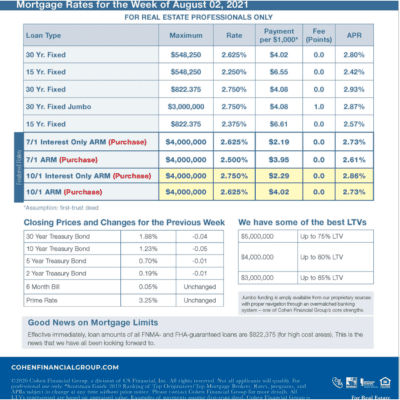There was no shortage of major economic news this last week, but none caused many reactions. The Fed meeting produced no significant surprises, and the GDP report was roughly neutral overall. Mortgage rates ended the week a little lower.
GDP falls short of expectations.
The headline number for second-quarter gross domestic product (GDP), the broadest measure of economic activity showed annualized growth of just 6.5%, well below the consensus forecast of 8.5%. However, the details of the report revealed that the shortfall was almost entirely in areas that simply postponed growth until future quarters. For example, inventory drawdowns subtracted roughly 1.2% during the quarter, as supply shortages caused delays in the production of cars, homes, and many other items. These inventories will need to be replaced, adding to future economic activity.
Underlying demand remained very strong, as personal consumption expenditures surged 11.8%. With the second-quarter growth, the size of the economy is now larger than before the pandemic, and early estimates for third quarter GDP growth are for an even stronger 7.0% annualized rate.
PCE reached new highs.
The core PCE price index is the inflation indicator favored by the Fed. In June, core PCE was 3.5% higher than a year ago, a little below the consensus forecast, but up from an annual rate of increase of 3.4% last month and just 1.5% in February. This
was the highest annual rate in decades. While economists have been expecting readings of this magnitude during the reopening of the economy, there are differing views on whether higher inflation will be a temporary spike or persist for years.
The Fed says “the economy has made progress”.
The Fed provided very little new or unexpected information at their meeting last Wednesday. Since March 2020, the Fed has been buying $120 billion of mortgage-backed securities (MBS) and Treasuries to help the economy offset the negative
effects of the pandemic. This year, Fed officials have repeatedly said that they will not begin to scale back (taper) these purchases until the economy achieves
“substantial further progress” toward reaching their labor market and inflation targets. Investors have been constantly seeking more concrete information about the projected timeline, but officials again provided no precise guidance. The statement
released after the meeting simply said that the economy “has made progress” toward its goals this year. The increased demand for MBS from the Fed helped push mortgage rates to record lows, so investors are keeping a close eye on the future outlook for the bond-buying program.
Major Economic News Due This Week
Looking ahead, investors will closely watch Covid case counts around the world. They also will look for hints from Fed officials about the timing for changes in monetary policy. Beyond that, the monthly Employment report will be released on Friday, and these figures on the number of jobs, the unemployment rate, and wage inflation will be the most highly anticipated economic data of the month. Before that, the ISM national manufacturing index will come out today and the ISM national services index on Wednesday.

Mortgage Rates week of 8-2-2021
